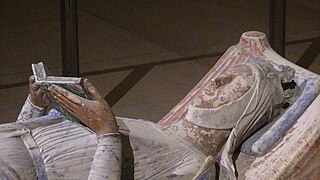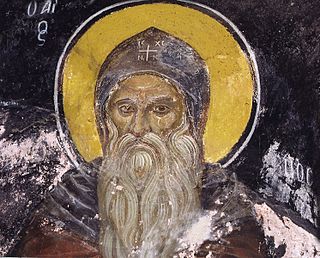Related Research Articles

Eleanor of Aquitaine was Duchess of Aquitaine in her own right from 1137 to 1204, Queen of France from 1137 to 1152 as the wife of King Louis VII, and Queen of England from 1154 to 1189 as the wife of King Henry II. As the heiress of the House of Poitiers, which controlled much of southwestern France, she was one of the wealthiest and most powerful women in Western Europe during the High Middle Ages. Militarily, she was a key leading figure in the Second Crusade, and in a revolt in favour of her son. Culturally, she was a patron of poets such as Wace, Benoît de Sainte-Maure, and Bernart de Ventadorn, and of the arts of the High Middle Ages.
Palladius was the first bishop of the Christians of Ireland, preceding Saint Patrick. It is possible that some elements of their life stories were later conflated in Irish tradition. Palladius was a deacon and member of one of the prominent families in Gaul. Pope Celestine I consecrated him a bishop and sent him to Ireland "to the Scotti believing in Christ".

Cenobiticmonasticism is a monastic tradition that stresses community life. Often in the West the community belongs to a religious order, and the life of the cenobitic monk is regulated by a religious rule, a collection of precepts. The older style of monasticism, to live as a hermit, is called eremitic. A third form of monasticism, found primarily in Eastern Christianity, is the skete.
Egeria, Etheria, or Aetheria was a Hispano-Roman Christian woman, widely regarded to be the author of a detailed account of a pilgrimage to the Holy Land about 381/2–384. The long letter, dubbed Peregrinatio or Itinerarium Egeriae, is addressed to a circle of women at home. Historical details it contains set the journey in the early 380s, making it the earliest of its kind. It survives in fragmentary form in a later copy—lacking a title, date and attribution.

The title archimandrite, used in Eastern Christianity, originally referred to a superior abbot whom a bishop appointed to supervise several "ordinary" abbots and monasteries, or as the abbot of some especially great and important monastery.
Flavius Rufinus was a 4th-century Eastern Roman statesman of Aquitanian extraction who served as Praetorian prefect of the East for the emperor Theodosius I, as well as for his son Arcadius, under whom Rufinus exercised significant influence in the state affairs.

Melania the Elder, Latin Melania Maior was a Desert Mother who was an influential figure in the Christian ascetic movement that sprang up in the generation after the Emperor Constantine made Christianity a legal religion of the Roman Empire. She was a contemporary of, and well known to, Abba Macarius and other Desert Fathers in Egypt, Jerome, Augustine of Hippo, Paulinus of Nola, and Evagrius of Pontus, and she founded two religious communities on the Mount of Olives in Jerusalem. She stands out for the convent she founded for herself and the monastery she established in honour of Rufinus of Aquileia, which belongs to the earliest Christian communities, and because she promoted the asceticism which she, as a follower of Origen, considered indispensable for salvation.

Melania the Younger is a Christian saint, Desert Mother, and ascetic who lived during the reign of Emperor Honorius, son of Theodosius I. She is the paternal granddaughter of Melania the Elder.

The sack of Rome in 455 AD marked a pivotal moment in European history when the Vandals, a Germanic tribe led by King Genseric, invaded the city. The Vandals pillaged the city for two weeks, causing widespread destruction. The event, following the Visigothic sack of 410, shocked the Roman world and symbolized the decline and impending fall of the Western Roman Empire.

Pambo was a Coptic Desert Father of the fourth century and disciple of Anthony the Great. His feast day is July 18 among the Oriental Orthodox, Eastern Orthodox, and Catholic churches.

The Lausiac History is a seminal work archiving the Desert Fathers written in 419–420 AD by Palladius of Galatia, at the request of Lausus, chamberlain at the court of the Byzantine Emperor Theodosius II.
Palladius of Galatia or Palladius of Helenopolis was a Christian chronicler and the bishop of Helenopolis in Bithynia. He was a devoted disciple of Saint John Chrysostom. He is best remembered for his work, the Lausiac History. He was also the author of the Dialogue on the Life of Chrysostom. Palladius is a saint in the Coptic Orthodox Church and in the Syrian Orthodox Church, wherein he is given the honorific title, The Solitary. His feast day is November 29.

Saint Isidora, or Saint Isidore, was a Christian nun and saint of the 4th century AD. She is considered among the earliest fools for Christ. While very little is known of Isidora's life, she is remembered for her exemplification of the writing of St. Paul that “Whosoever of you believes that he is wise by the measure of this world, may he become a fool, so as to become truly wise.” The story of Isidora effectively highlights the Christian ideal that recognition or glory from man is second to one's actions being seen by God, even if that means one's actions or even one's self remains unknown or misunderstood. This ideal was extremely important to the early Desert Fathers and Mothers who recorded Isidora's story.

Joseph Armitage Robinson was a priest in the Church of England and scholar. He was successively Dean of Westminster (1902–1911) and of Wells (1911–1933).
Eusebius was a high-ranking officer of the Roman Empire, holding the position of praepositus sacri cubiculi during the rule of Emperor Constantius II (337-361).

The Vitae Patrum or Vitas Patrum is a collection of hagiographical writings on the Desert Fathers and Desert Mothers of early Christianity.

Desert Mothers is a neologism, coined in feminist theology as an analogy to Desert Fathers, for the ammas or female Christian ascetics living in the desert of Egypt, Palestine, and Syria in the 4th and 5th centuries AD. They typically lived in the monastic communities that began forming during that time, though sometimes they lived as hermits. Monastic communities acted collectively with limited outside relations with lay people. Some ascetics chose to venture into isolated locations to restrict relations with others, deepen spiritual connection, and other ascetic purposes. Other women from that era who influenced the early ascetic or monastic tradition while living outside the desert are also described as Desert Mothers.
Aspona was an ancient city and bishopric in Galatia, in central Asia Minor. It corresponds to the modern settlement of Sarıhüyük.
ʿEnanishoʿ was a monk, philosopher, lexicographer and translator of the Church of the East who flourished in the 7th century.
Abba Pitirim of Porphyry or Pitirim of Egypt was an Egyptian Christian monastic and saint of the fourth century, and a disciple of Anthony the Great. His feast day is November 29 in the Orthodox Church.
References
- ↑ Bardenhewer, Otto (1908). Patrology; the lives and works of the fathers of the church. trans. Thomas Joseph Shahan. B. Herder. p. 424.
- ↑ Palladius of Galatia (1918). The Lausiac History Of Palladius. W. K. Lowther Clarke. The Macmillan Company. Retrieved 2015-08-16. html
- ↑ M.L. McClure; C. L. Feltoe (1919). "Introduction". The Pilgrimage of Etheria. Society for Promoting Christian Knowledge.